Before you can set or negotiate an employee’s pay level, you’ll want to compare salaries using compensation data you’ve gathered for similar roles. The best salary comparison tools provide access to a wide range of data—from staff wages and bonuses to employee benefits—that cover many job types, skills, and positions across industries and locations.
To find the best salary research tools for small businesses, I evaluated nine options and narrowed them down to my top six.
- Bureau of Labor Statistics: Best overall salary comparison tool
- Indeed: Best for employee- and employer-reported salary data
- PayLab: Best global salary benchmarking tool
- ZipRecruiter: Best for easy-to-understand salary research reports
- Payscale: Best compensation scenario builder
- Salary.com: Best unique salary data filters
Featured Partners
All the salary comparison websites on my list offer at least some of their services for free. These include access to salary ranges, salary views by job and location, and a search function for a single job by title and location. Reports are also available, and most options are downloadable.
Best Salary Comparison Tools Compared
Expert Score (out of 5) | Starter Pricing | Salary Data Source | Pay Bonus Data | Basic Benefits Information | |
|---|---|---|---|---|---|
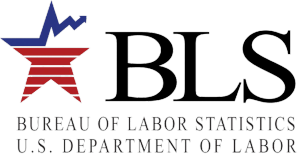 | 4.12 | Free | From employers | Only shows the percentage of survey respondents that offer it | ✓ |
 | 4.06 | Free | From employers and employees | ✕ | ✕ |
 | 3.93 | From employees | ✓ | ✓ | |
3.91 | Free | From employers | ✕ | ✕ | |
 | 3.72 | Call for a quote | From employers and employees | ✓ | ✓ |
 | 3.69 | Call for a quote | From employers | ✓ | ✓ |
Having a competitive compensation package is just one aspect of an effective hiring process. To learn more, check out our articles on how to find the best employees and how to write an effective job description that attracts the top candidates.
1. Bureau of Labor Statistics: Best Overall Salary Comparison Tool

Pros
- It offers free access and download of reports
- It has a large database with robust data filters
- It can show different median wages for the same role in various industries
Cons
- It has no list of high-paying companies for a selected position
- Bonus data is unavailable; only lists the percentage of company-respondents that offer it
- Some reports require additional resources to check position and/or industry codes
Overview
Who should use it:
The Bureau of Labor Statistics (BLS) ranks as my top choice for salary benchmarking tools given its free salary research reports, nationwide employer-reported data, and multiple filter options. It is perfect for any small business that needs to rely on sourced data to make salary-related decisions.
Why I like it:
The BLS salary survey is the largest of its kind. It’s a highly scientific government-run survey that’s free to download. The data is sourced from quarterly nationwide employer salary surveys and has the most robust filtering and download capabilities. This helps you account for organizational, regional, and other data variations in compensation. However, the quarterly reports are summaries; the job-specific searchable reports are updated each May.
In my evaluation of the best salary comparison tools, it earned an overall score of 4.12 out of 5. The standardized dataset and filters are great, but these come at the cost of ease of use. The BLS interface is unwieldy and difficult to navigate. The database may be extensive but is not very granular because of
the standardization technique. This means you may not be able to find a precise match for your particular job if it doesn’t match an occupation or industry that the BLS uses. There is no company-specific data either, which makes competitive analysis more difficult.
The BLS’s wide selection of salary surveys and wage comparison reports are free to download.
- Multiple filter options: Sort data by organization size, part-time and full-time work status, incentive-based and time-based pay, work level, job characteristics, and bargaining status (whether union or nonunion)—a filter option that only the BLS offers. You can also filter by national, regional, state, metropolitan area, and county data.
- Downloadable reports: Depending on the type of report selected, you can download salary data in PDF and XLS file formats. Some reports have an HTML option as well. The BLS even lets you download its survey charts as JPEG and PNG images that you can attach to your own reports.
- Application programming interface (API): You can incorporate BLS data into an existing salary research program via API. It offers two versions. Version 1 is for public use but more limited; Version 2, while free, requires registration. It allows users to access more data more frequently, and add calculations and annual averages to requests.
- Standardized positions: Its database covers 800 occupations and 400 industries with wage data that follows North American Industry Classification System (NAICS) industry codes. Its dataset of standardized job titles and position descriptions also allows you to make apples-to-apples comparisons.
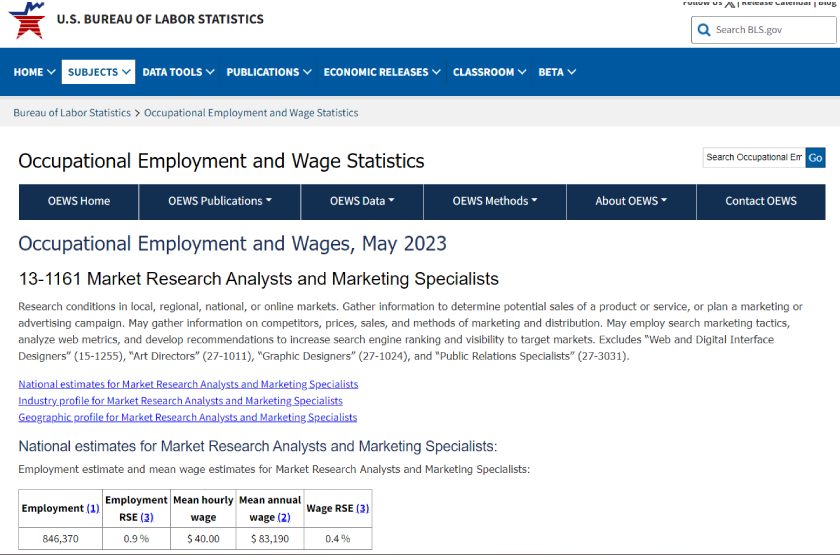
Job wage summary from the Bureau of Labor Statistics salary survey (Source: BLS)
2. Indeed: Best for Employee- and Employer-reported Salary Data

Pros
- It’s completely free; no limits
- It shows jobseeker ratings for specific categories (such as compensation, job security, company culture, management, and work-life balance)
- It lists highest-paying companies for the position and location selected
Cons
- It only displays base salary and commission amounts (if applicable to the position); benefits that are common across similar job roles are not included
- Filter tools aren’t robust; you have to scroll through its website for salary comparisons to see pay information based on jobs type and location
- It lacks downloadable salary compensation reports
Overview
Who should use it:
Startups needing a more robust dataset to set competitive salary ranges for their new workforce will benefit the most from Indeed’s employee and employer-reported compensation data. Indeed is also a great choice if you’re a small business already using Indeed’s job board to advertise your open roles. Plus, you can access both capabilities on Indeed for free.
Why I like it:
Indeed is one of the largest and most popular job posting sites on the market and offers salary comparison tools that are completely free to use. With a database of over 500 million salaries, you can easily view jobs that have similar titles or job descriptions to yours.
Unlike the other salary comparison sites on my list, which only have employee or employer data or both, Indeed’s database consists of pay information from job listings posted on its site in the previous 36 months and those anonymously reported by employees and employers. This makes it easier for you to do a competitor analysis and gauge whether or not your pay package is at par with the market.
These features contributed to Indeed’s overall score of 4.06 out of 5. It may have a large salary database, but its filter tools aren’t as robust as the BLS or Salary.com’s. You also can’t download salary comparison reports. While it previously showed the types of employee benefits that employers typically offer for a position, this option is no longer available.
While Indeed’s salary comparison tool is free to use, you have to pay for its other solutions, like sponsored job listings (budgets start at $5 per day or $150 per month) and resume searches ($120 or $400 per month). However, posting jobs on its platform comes at no cost.
- Competitor analysis: Since Indeed is one of the most popular job posting sites and has a large salary database, chances are pretty good that you’ll see how much competing companies are offering for the same position. Indeed even lists the companies that offer competitive salaries, including how much they pay for the position—data that ZipRecruiter, Salary.com, and the BLS don’t offer.
- Salary satisfaction ratings and pay range data: Indeed has a down-drop button that lets you view salaries on a daily, weekly, monthly, and annual basis. Data about the average hourly or salary pay for a specific job title is available, including the pay range for that job title. It also lets you see the salary satisfaction ratings for a position, providing you insight into how competitive your salary range might be. However, Indeed lacks the bonus amounts that many of the providers on our list (except ZipRecruiter and the BLS) have.
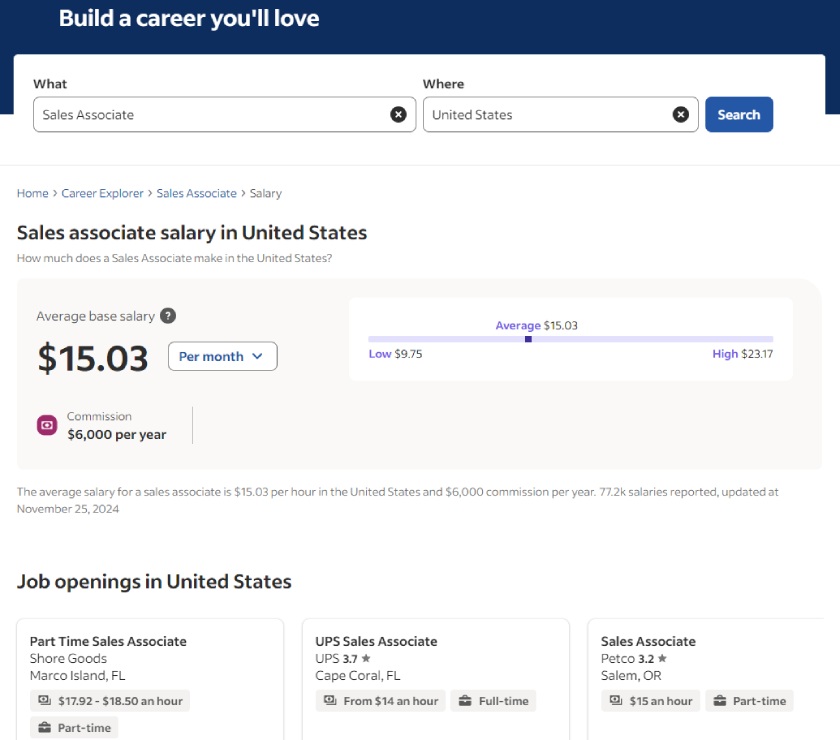
Indeed salary comparison site (Source: Indeed)
3. PayLab: Best Global Salary Benchmarking Tool

Pros
- It allows over 370,000 salary profiles
- It allows international salaries
- Its mobile app is easy to use
Cons
- Fees are in Euro
- Free trial is highly limited
- Data is not government-sourced but instead relies on employee input
Overview
Who should use it:
PayLab’s international salary database makes it an ideal option to compare basic employee compensation data for US and global labor markets.
Why I like it:
PayLab is one of the few on my list of the best salary comparison tools that provide compensation information for countries outside the US. It offers sample salaries of more than 700 job positions in over 35 countries in Europe, Africa, and Asia. This is great if you hire internationally and want to offer competitive salaries.
It has detailed salary reports that show the selected position’s pay ranges by various data points, such as education and company size. It even has a graph of the most common benefits that companies offer for the role. While these functionalities helped to pull PayLab’s overall rating to 3.93 out of 5, it scored the lowest in pricing because all of its features are locked behind a paywall and it charges in Euro.
You can sign up for its starter Solo plan, but it’s only for a one-time salary analysis. If you need to check the salaries of multiple roles, you have to upgrade to its higher tiers.
Unlike the other salary research tools that I reviewed, PayLab’s pricing matrix is in Euro. It offers three plans:
- Solo: €99 or approximately $103.87 (as of this writing); includes access for one user and salary analysis for one position
- Twenty: €990 or approximately $797.39 (as of this writing); includes access for one user and salary analysis for 20 positions per year
- Unlimited: Starts at €760 for three months or approximately $796.02 (as of this writing); includes unlimited users and positions and salary comparisons for up to two countries
- International salaries: You’ll have access to over 370,000 salary profiles in nearly 700 job positions across more than 35 countries. The data is pulled from employee surveys and vetted. It also verifies listings against job advertisements to get the most accurate data set.
- Versatile salary tool: Its salary tool lets you compare positions, see an overview of financial and nonfinancial benefits, and save reports as PDF or CSV. If your employee does tasks from multiple positions or you cannot find a comparable job, you can view the salaries of multiple positions to get a feel for an appropriate pay scale.
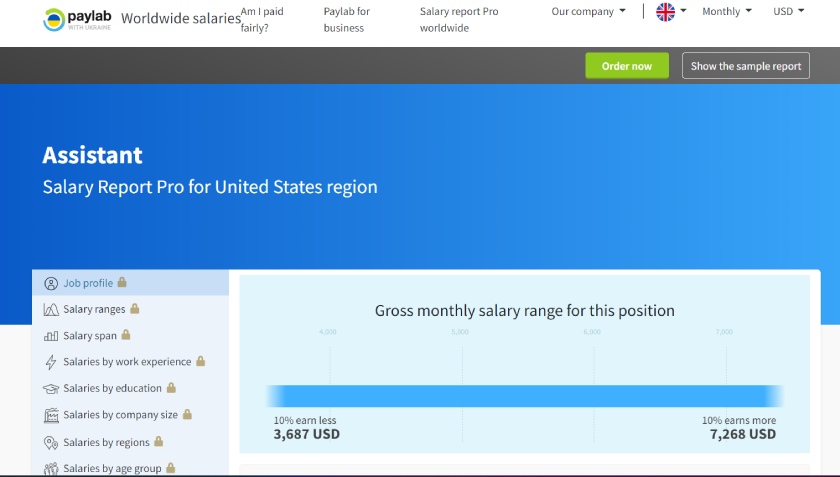
PayLab lets you view a position’s salary details by different data points, such as age group, education level, and pay range. (Source: PayLab)
4. ZipRecruiter: Best for Easy-to-Understand Salary Research Reports

Pros
- It’s free and easy to use
- It has an online salary comparison summary that’s simple yet easy to understand
- Salary database covers 35,000 job titles
Cons
- Comparison reports aren’t downloadable
- Bonus and benefits data not available
- Data filters are limited; it only allows you to view salaries by the hour, week, month, or year and in table format
Overview
Who should use it:
If you’re a small business with workers throughout the US, ZipRecruiter provides both local and nationwide salary comparisons on a user-friendly platform. You can also leverage ZipRecruiter’s online talent marketplace and recruitment solution for posting jobs and finding qualified candidates.
Why I like it:
ZipRecruiter, like Indeed, is a popular job posting site with a free-to-use salary comparison tool. It gets most of its salary data from open jobs that employers and recruiters post on its site. What sets it apart from Indeed is that it also pulls salary information from third-party data sources, such as ADP.
In my evaluation, ZipRecruiter received an overall score of 3.91 out of 5. It’s the best site to get salary info that is easy to understand. Unlike Indeed, you don’t have to use its drop-down tool to select a pay period and then wait several seconds for the position’s salary data to load. You simply click your preferred option (e.g., annual, monthly, or weekly) and the salary information will load instantly. Plus, if you hover your cursor on the online report’s different salary bars, it shows the percentage of similar job postings that offer that pay range.
However, you can’t download salary research reports. This is unlike BLS, which allows you to save graphs. It also lacks information about bonuses, payments, and benefits, including filter tools to view salary data based on various factors (like education level and years of work experience).
You can use ZipRecruiter’s salary research tool at no cost. For its paid solutions—which include one-click job postings, resume bank access, and unlimited candidate applications—you have to contact the provider to request pricing.
- Salary research summary: ZipRecruiter is the only provider on this list that shows details of its salary research both in graph and report format. These are helpful in translating the numbers into information you can use when checking a position’s salary competitiveness and planning what pay rate to add to job offer letters.
- Quick salary views: It may not have multiple data filters like Salary.com and the BLS, but ZipRecruiter has salary view options that let you quickly display the position’s hourly, weekly, monthly, and yearly pay data. While Indeed may have similar options, ZipRecruiter offers an additional “table view” that shows the salary range and average pay for various pay periods.
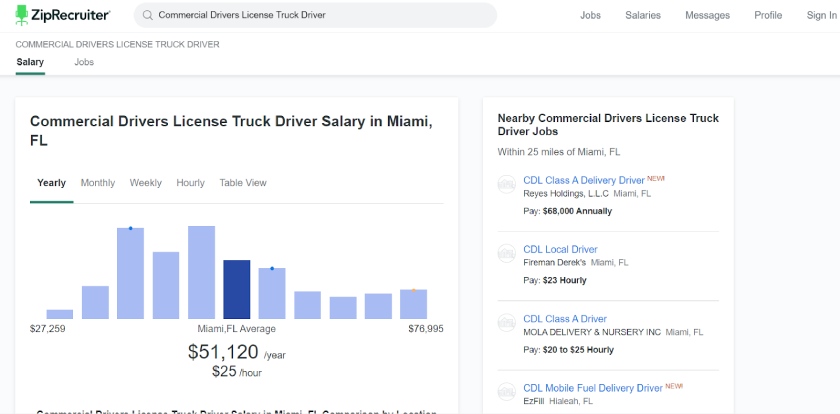
ZipRecruiter shows you an average salary for a specific job duty in your city and state. Plus, it shows a listing of relevant jobs in the area so you can compare. (Source: ZipRecruiter)
5. Payscale: Best for Creating Custom Compensation Scenarios

Pros
- It has a compensation scenario builder
- It has a wide range of survey and compensation management solutions
- It offers products with robust employee- and employer-reported data; has over 5,700 benchmarked jobs in nearly 260 industries
Cons
- Pricing isn’t transparent
- Free-to-use salary report for individuals isn’t intuitive; requires several clicks to find data for a specific position
Overview
Who should use it:
Payscale’s compensation planning features make it a great salary research tool to prepare budgets for upcoming merit increases and promotions, including the potential addition of new roles to the organization.
Why I like it:
Payscale is an easy-to-use tool that includes robust employee- and employer-reported data (but no job posting data like Indeed). It has a wide range of compensation management and survey tools like Salary.com, although Payscale lets you build your own compensation scenarios in case you need to create new positions or a completely new business. This allows you to get a holistic idea of your staffing costs, more so than the other providers in this guide (although PayLab will let you set up cumulative positions for multiple salaries at once).
It earned an overall score of 3.72 out of 5 in my evaluation, with a perfect rating in salary comparison features. However, you need to sign up for a paid plan to use its compensation planning tools and other job pricing tools. While it has a free salary report for individuals or jobseekers that you can also use to see if your pay package is competitive, it isn’t as straightforward to use as Indeed or ZipRecruiter. You have to click several options to find the position you want.
Payscale offers three plans:
- Basics: Call for a quote; includes tools to quickly access market data for price jobs
- Professional: Call for a quote: Basics + additional features to help you create and manage salary structures, pay strategies, and reports
- Advanced: Call for a quote; Professional + survey management features
It also offers add-on products if you want specific functionalities, such as salary data reports from peer companies, automated survey management tools, and a compensation planning module. Contact Payscale to request a quote for these solutions.
- Compensation scenario builder: With Payscale, you can create compensation scenarios to help you check market data and pay trends. This makes business planning easier, as you can get a holistic view of salary costs when you plan to set up a new business venture or enhance your organizational structure by adding new roles.
- Feature-rich solution suite: Payscale has a wide range of solutions for building and managing your company’s compensation package and strategies. In addition to salary research tools, it offers compensation management software, an online job description manager that allows you to store and create job descriptions, and a salary calculator that helps you gauge whether or not your pay rate is competitive.

Payscale allows you to view average salaries; however, a detailed report will cost additional. (Source: Payscale)
6. Salary.com: Best Unique Filters for Viewing Compensation Data

Pros
- Employer-reported salary information has over 15,000 job titles in 225 industries
- It offers a wide range of survey and compensation management solutions
- It has multiple data filters and includes unique selections for sorting data based on performance, reporting lines, and number of direct reports
Cons
- Navigating through all its solutions and services can be a bit confusing
- Some products are expensive; it can be costly for small businesses, especially if you get multiple tools
- Results of the online salary calculator can’t be downloaded
Overview
Who should use it:
Salary.com may be right for your business if you need specific data filters with the ability to sort and view compensation data across multiple channels.
Why I like it:
Salary.com is one of the oldest sources of salary data on the web—the company was founded in 1999. It has 100% employer-reported survey data purchased from data collectors and even offers a wide range of compensation management and salary survey products. The pay information is updated monthly and can be filtered in ways unavailable on other salary information sites, such as salary views based on performance and management level.
These functionalities contributed to its overall score of 3.69 out of 5. While it has a free-to-use salary calculator, you have to pay extra if you want to download most of its reports. The salary calculator also has ad placements, which can be intrusive.
Salary.com has several free-to-use solutions like its online salary calculator with unique filters and reports that show benefits data and HR metrics. It also offers paid products, such as:
- Price a Job reports: Credits to download compensation, open position, employee, and salary adjustment reports
- One report credit: $245
- Three report credits: $661
- Five report credits: $1,041
- Seven report credits: $1,372
- 10 report credits: $1,837
- 15 report credits: $2,573
- CompAnalyst Market Data: Call for a quote
- Compdata Survey: Call for a quote
- Salary and benefits comparison data: You get a comprehensive salary data range that shows averages and quartile percentages—enabling you to see the selected position’s wage distribution at 10%, median (50%), and up to 90%. Bonuses and benefits data are also provided.
- Feature-rich platform: Aside from comprehensive industry wage reports and compensation consulting services, it offers solutions for managing job descriptions and ensuring pay equity across your company. It even has a Job Skills Model tool that lets you build a skills and competency framework to help simplify job structures and align compensation with performance.
- Unique filters: Apart from location, education, and years of work experience, you can sort salary data by work performance levels, reporting lines, and number of direct reports. The performance filter applies standardized categories—such as “excellent,” “above expectations,” and “poor”—to each position. This would be most helpful, perhaps not for determining what to offer when hiring employees but in identifying promotions and pay raises during annual performance reviews.
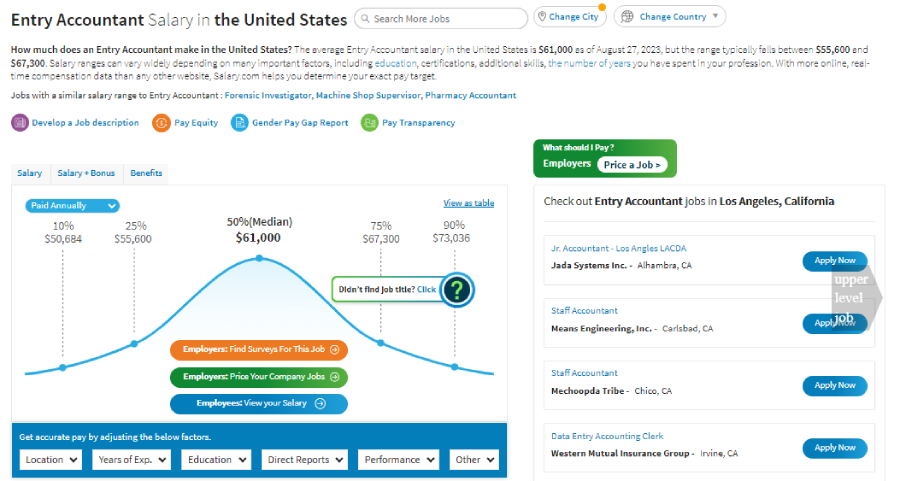
Salary.com’s online salary calculator (Source: Salary.com)
How to Choose the Best Salary Comparison Tools
Conducting salary research is a critical part of creating your company’s compensation program. It helps ensure that you’re paying employees at par with market rates, enabling you to attract qualified candidates and improve employee retention. Regardless of which salary comparison sites you use, here are a few key things you should do when choosing the best one for your small business.
- Understand job matching variables: Salary ranges for any job title can vary greatly based on a number of factors, such as location, education, years of experience, and industry. For example, an engineer in New York City needs to make more than the same engineer in Iowa to have the same standard of living.
- Consider similar job titles: Job titles vary greatly, so consider job titles that are similar when gathering salary data. Filter by as many variables as you can to get data that closely matches the position you are researching.
- Balance job match quantity vs quality: Strive to strike the right balance between the exact job match and a number of data points. The closer you can match a comparison profile with your job profile, the more relevant the comparison data is. However, as you add constraints like experience or region, you’ll reduce the size of your dataset. Reduce it too much, and you won’t have a large enough data set for a reliable comparison.
- Calculate compa ratio: Because you want to create a competitive salary package, you should not focus on a single number. Calculate a comparison range and a compa ratio (short for comparison ratio), which compares the salary you are paying your employees versus the market midpoint for similar positions at other companies. Decide where on the scale you should fall to be competitive, considering your employer brand and other things you offer your employees, such as benefits, flexible scheduling, and bonus payouts.
Methodology: How I Evaluated the Top Salary Comparison Websites
Evaluation Criteria
To evaluate the top salary research tools for small businesses, I used a rubric containing several criteria that looked at the software’s features, pricing, ease of use, and reporting tools. For this guide, I looked at nine salary information websites. These are as follows:
- Indeed
- Bureau of Labor Statistics
- Salary.com
- Payscale
- ZipRecruiter
- SalaryList
- PayLab
- LaborIQ
- SalaryExpert
Then, I compared each solution and looked for key salary comparison features to help business owners determine if their pay rates are at par, below, or above market rates. Of the nine solutions on my list, I narrowed it down to the six best salary benchmarking tools.
To view the full evaluation criteria, click through the tabs in the box below.
25% of Overall Score
40% of Overall Score
Providers with a large database and those with data filtering capabilities were rated favorably. I also looked at the data source (i.e., employer- or employee-reported or both) and if the salary information provided includes benefits and bonuses as well as average pay and salary range details.
20% of Overall Score
In this criterion, I looked for salary comparison reports that are downloadable and easy to understand.
15% of Overall Score
I gave more points to tools with intuitive interfaces and considered whether users will need to spend a lot of time learning how to navigate through their features. I also checked if the tools have a mobile-friendly platform and offer help options such as online manuals, video tutorials, and live support.
Meet the Experts
The following HR experts contributed to this article:
 | Robie Ann Ferrer is an HR expert writer at Fit Small Business, focusing on small business HR and payroll software content. Her 10 years of experience handling different facets of HR and over eight years of content writing experience allow her to provide insights and HR software recommendations to help small businesses manage employees and HR processes. |
 | Jessica Dennis is the HR lead writer at TechnologyAdvice and also lends her expertise in reviewing content for Fit Small Business. She has B.A. in English Literature from the University of Michigan and over six years of experience in onboarding, payroll, benefits, compliance, and workforce management as an HR generalist. Since joining TA, she’s covered additional topics like DEI, engagement, training, communication, hiring, and performance management best practices. Her expertise, in-depth research, and hands-on experience with HR software ensure she provides the best people operations and technology insights to readers. When she’s not writing, you can find her obsessing over her Labrador Retriever, crocheting, or jumping into the nearest body of water. |
Frequently Asked Questions (FAQs) About Salary Comparison Tools
The best site to get salary info is the Bureau of Labor Statistics (BLS). It has a comprehensive salary database with survey data from various US companies in different industries and for 830 jobs. Best of all, you can access its reports for free. It’s also a government-run survey, making it easy for you to access salary data for specific areas and industries nationwide.
To compare salaries between jobs, you have to look at different factors, like the role itself, the skills and competencies needed to perform the job, the location and size of the company, and the industry your business belongs to. You also need access to a database that contains the base salaries, bonus amounts, and benefits details of jobs in similar companies. This is where salary benchmarking websites and compensation survey service providers can help, as they provide all the tools you need to compare your salary package with market rates.
This depends on your salary comparison needs. If you’re looking for a quick way to check if the salary you’re offering for a specific role is competitive, use the free salary calculators that job posting sites like Indeed and ZipRecruiter offer. If you want a more comprehensive dataset, I recommend the reports and tools you can access through the Bureau of Labor Statistics and online salary information websites, such as Payscale and Salary.com.


